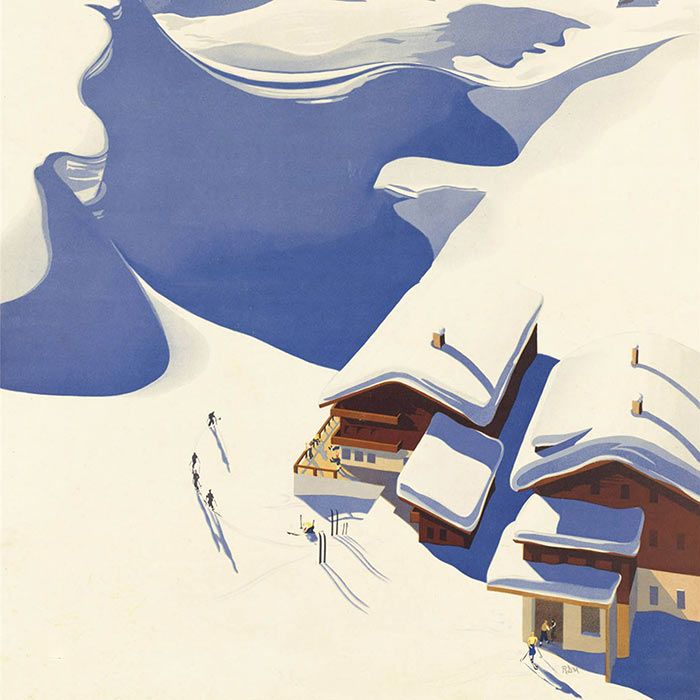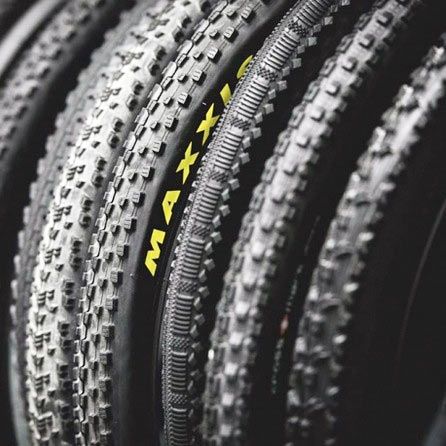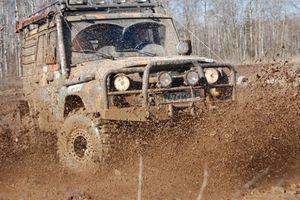 Jeep racing in the mud
There is a sizable group of people who are completely indifferent to one of Russia’s greatest challenges—its roads. In fact, they specifically seek out areas with minimal road networks, filled with difficult terrains and obstacles. These are the fans of one of the most extreme types of technical sports and outdoor activities—off-roading.
Jeep racing in the mud
There is a sizable group of people who are completely indifferent to one of Russia’s greatest challenges—its roads. In fact, they specifically seek out areas with minimal road networks, filled with difficult terrains and obstacles. These are the fans of one of the most extreme types of technical sports and outdoor activities—off-roading.
At its core, off-road (from the English “off-road”) refers to traversing rugged terrain and off-road conditions by vehicle, whether it’s a car or even a motorcycle. Except for major international rallies, there are no strict rules—competition organizers determine them individually for each route or tournament (or festival). On the surface, the goal is simple: try to reach the finish line with minimal losses while ideally outpacing the competition. However, the main challenge is simply being able to complete the route!
In Russia, this motorsport has gained significant popularity; the country’s vast expanses and many unexplored (or inaccessible) areas make it ideal for off-road adventures. European athletes even envy Russians for having such opportunities to train and compete! It’s no surprise that off-road clubs have popped up in many cities across the country, and trophy raids and rallies through Russian territory are widely attended and highly acclaimed.
Waveboard Learn more about the new type of roller board— waveboarding on our website.
Manufacturers of optical equipment offer a wide selection of binoculars for hiking, hunting, or fishing. Learn how to understand the specifications and make the right choice in this guide .
The History of Russian Off-Roading
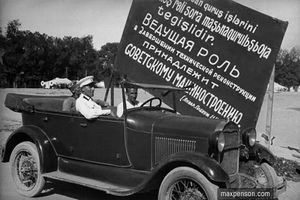 Participants in a road rally
The emergence of such enthusiast clubs in Russia began in the early 1990s. However, as early as the 1930s, road rallies were held in the country, and due to the completely undeveloped road network at the time, they can rightfully be considered early examples of off-roading. Who could forget the famous satirical novel The Golden Calf, with Ostap Bender’s iconic slogan: “Let’s tackle bad roads and negligence with a road rally!”
Participants in a road rally
The emergence of such enthusiast clubs in Russia began in the early 1990s. However, as early as the 1930s, road rallies were held in the country, and due to the completely undeveloped road network at the time, they can rightfully be considered early examples of off-roading. Who could forget the famous satirical novel The Golden Calf, with Ostap Bender’s iconic slogan: “Let’s tackle bad roads and negligence with a road rally!”
One of the most significant and large-scale rallies of that time occurred in 1933. The Gorky Auto Plant had just come into operation, and A.M.O. (later renamed ZIL) was gaining momentum. It was decided to test the capabilities of domestic vehicles under the harshest conditions and compare them with overseas models.
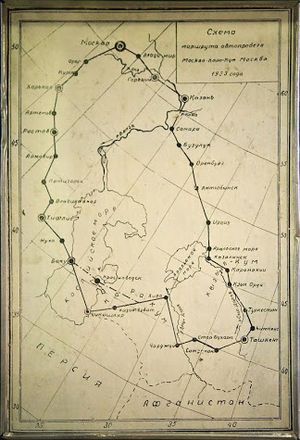 Route map
Twenty-three crews participated: six GAZ-A cars, six “one-and-a-half-ton” GAZ-AA trucks, two experimental three-axle GAZ-AAA vehicles, one prototype model NATI-GAZ, four AMO-3 2.5-ton trucks, three three-axle Ford-Timkens, and one Ford-AA.
Route map
Twenty-three crews participated: six GAZ-A cars, six “one-and-a-half-ton” GAZ-AA trucks, two experimental three-axle GAZ-AAA vehicles, one prototype model NATI-GAZ, four AMO-3 2.5-ton trucks, three three-axle Ford-Timkens, and one Ford-AA.
Even by today’s standards and with modern off-road vehicles, the route is considered extremely challenging. The rally began in Moscow, proceeded to Gorky, followed the Volga River to Samara, and turned toward Orenburg.
Beyond Orenburg lay the vast Kazakh steppes, leading to the shores of the Aral Sea. Key points from there included Tashkent, Samarkand, Bukhara, and Chardzhou. From Chardzhou, the most difficult section began through the “Black Sands,” the Karakum Desert, to Krasnovodsk on the Caspian Sea.
Apart from the complete lack of roads, water shortages were a major issue, so the route was plotted from well to well. Navigation tools were virtually non-existent, and locals from Turkmenistan served as guides. Inside the vehicles, temperatures reached as high as 75 degrees Celsius, causing engines to overheat, and crews often had to use their drinking water for cooling.
Some sections required the vehicles to be practically “carried by hand.” In desert conditions, three-axle vehicles and those equipped with wide tires—referred to at the time as “balloon tires”—performed the best.
After crossing the Caspian Sea by ferry, the rally continued through Baku, Tiflis, Rostov, Kharkiv, Tula, and concluded on September 30, 1933, in Moscow.
The results were astonishing: ALL vehicles finished the rally, and there were no casualties among the crews. Over a period of just under three months, participants covered 9,400 kilometers, of which only slightly more than 2,000 were on low-quality paved roads. The rest of the journey consisted of trails, caravan routes, and 1,200 kilometers of complete off-road terrain.
Видео "Как научиться паркуру"
Watch a video about how to learn parkour in our article “Parkour as a Way of Life.”
Many people have heard about the Sheregesh ski resort. If you are still unaware of the best place for skiers and snowboarders, visit this page .
We also have a story about Russia’s oldest and largest ski center, Dombay. Read it at this address .
Development of Modern Russian Off-road Movement
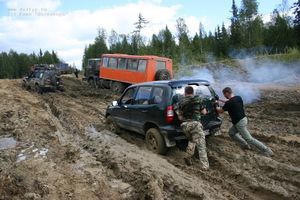 Truck Racing Through Mud
Truck Racing Through Mud
However, let’s return to the present.
It’s clear that many rural residents had to engage in off-road driving out of necessity. This made highly capable vehicles indispensable in such areas—GAZ-69, UAZ, the all-wheel-drive three-axle ZIL-131, GAZ-66, LuAZ, and the uniquely designed compact SUV VAZ-2121 “Niva”.
This necessity-based adaptation is understandable. But deliberately taking one’s car into rough terrain and pushing it to its limits? Yes, there are such enthusiasts, and they are far from few.
The organized development of off-roading in Russia was catalyzed by the famous “Camel Trophy” rallies, which took place on Soviet soil, in Siberia, in 1990. The competition results, which marked a triumph for the Soviet team, were widely covered in the press and on television.
Nonetheless, for amateur athletes, gaining entry to such events was almost impossible. To address this, a group of enthusiasts led by Mikhail Snarsky and Taras Nechiporenko gathered in Moscow, determined to secure funding and found the Russian club “Russian Off-road Center”.
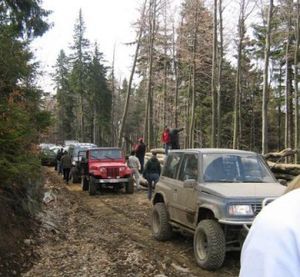 Off-roading in Nivas
Off-roading in Nivas
Their efforts bore fruit, and by 1993, the first competition under the club’s banner was held in Zvenigorod. Additionally, a sort of sports section called the “4x4 Club” was established at the Pioneer Palace on the Sparrow Hills, a name that has since become ubiquitous.
Saint Petersburg, Russia’s northern capital, took up the baton in 1995 by founding the “Off-road & 4x4 Club”, which regularly participated in the “Arctic Trophy,” a European favorite.
By 1997, a new off-road brand—“Ladoga Trophy”—was introduced, featuring a route around the largest lake in Europe. It quickly gained high acclaim and, since then, has been one of the most popular events, attracting hundreds of participants annually.
Nowadays, it seems that every major (and minor) city in Russia boasts its own off-road club. The geographic scope of raids, expeditions, festivals, and competitions has significantly expanded. Routes through the Northern Caucasus, the Upper Volga (“Suvorov Trophy”), Belarusian forests and swamps, the Ukrainian steppes, the Ural Mountains, and many other landscapes are quite popular.
Russian off-road enthusiasts regularly participate in international tournaments, ranging from rally-type competitions to full-fledged trophy raids.
Marble Cave in Crimea
Learn about the “Marble Cave” in Crimea and other prominent caves across the post-Soviet region on the linked page.
A relatively new hobby—fingerboarding—is becoming popular. Should it be considered a variant of skateboarding or even an extreme sport? Share your opinion in the comments section on this page .
What Are the Highlights of These Competitions?
Trophy Raids
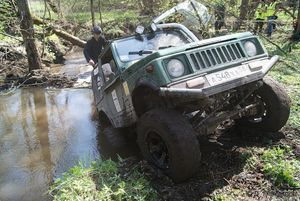 Off-roading in Jeeps
Off-roading in Jeeps
Typically, this type of competition does not prioritize speed as the main goal. The key element is successfully navigating through special and linear sections within the specified time limit. Each crew (usually two people in a vehicle—the driver and the co-driver/navigator) receives a task for each competition stage called the roadbook.
The challenge lies in the fact that, beyond driving in completely off-road conditions, teams have to independently navigate using GPS devices or topographic maps provided along with the task.
Special stages also exist, featuring increased difficulty with natural or artificial obstacles. Victory in these segments is determined by the time it takes to overcome them.
Of course, participating in such competitions requires meticulous preparation of the vehicle; technical support plays an absolutely crucial role. At times, cars are so thoroughly modified that they retain only a superficial resemblance to their original models. However, organizers account for this by dividing participants into several categories:
- “Raid” Group – factory-standard SUVs;
- TR-1 Group – vehicles with minor enhancements;
- TR-2 Group – cars with substantial modifications;
- TR-3 Group – custom-built off-roaders or highly modified vehicles with minimal restrictions.
There are also several categories for motorcycles and quad bikes.
As a rule, most off-road trophy raids are organized as open competitions, in which participants can pre-register with the event organizers.
Domestic Nivas and UAZs are essential participants in all trophy raids held on Russian territory. They perform just as well as the renowned Suzukis, Nissans, or Mercedes.
Rally Raids
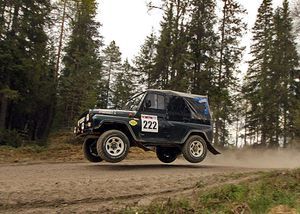 Off-road racing with UAZ vehicles
Off-road racing with UAZ vehicles
This is a more serious level of competition in off-roading. Rally raids are multi-day events of significant length where the speed at which the course is completed plays a crucial role.
Rally raids are divided into short raids, up to 1,200 kilometers long, known as Baja; rally raids covering distances of up to 6,500 kilometers and lasting up to 10 days; and marathon events.
The most grandiose marathon took place in 1992 along the route Paris-Moscow-Beijing. The course exceeded 17,000 kilometers, and racers spent an entire month completing it. The Russian automotive industry can take pride in this achievement—second place in the overall standings was secured by our team with a Lada Samara, surpassing Mitsubishi, Nissan, and Volkswagen!
The most popular rally raid was the Paris-Dakar race, which, however, was canceled for safety reasons.
Nevertheless, athletes always have opportunities to prove themselves. For instance, the Silk Way rally is gaining enormous popularity.
Rally raids have their own classification system for motorcycles and cars, which takes into account the type of vehicle, the degree of modifications, weight, and the type of fuel used.
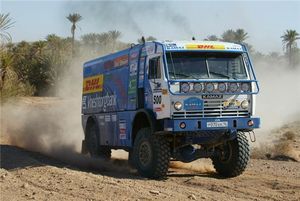 Racing with Kamaz trucks in the mud
Racing with Kamaz trucks in the mud
Class T-4 trucks—four-wheel-drive trucks weighing over 3.5 tons—are always an integral part of the competition. They are further divided into categories: T-4.1, with minimal enhancements, and T-4.2, with significant modifications within the limits set by the competition organizers.
Once again, we can’t help but celebrate our compatriots—the KAMAZ MASTER team from Naberezhnye Chelny is a multiple world champion and prizewinner in the most popular rally raids. They conquered the Paris-Dakar seven times! And their competitors are always formidable: the Dutch DAF, German Mercedes-Benz, and Czech LIAZ trucks.
Motorcyclists also compete in three different classes, further categorized by how “advanced” their bikes are: Production, Super-Production, and All-Terrain Vehicles (ATVs) .
Articles about sports often end with calls to action, such as “try this sport—it’s very rewarding.” However, it’s hard to say the same about off-roading. It likely requires a profound internal drive, a personal motivation not understood by many, to risk health and invest significant funds in exchange for the indescribable thrill of wild driving through complete wilderness.
Trophy Raid Video
Racing through mud and off-road terrain with Niva vehicles: https://www.youtube.com/watch?v=8 _21xIsR0Yk

